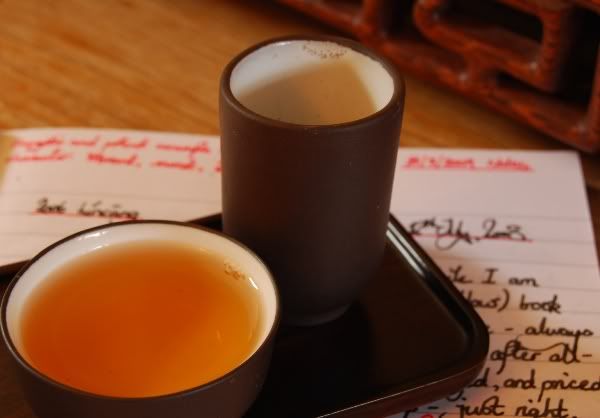I'm always a little sad to say goodbye to a good sample, especially when the tea is either no longer available, or prohibitively expensive.
So it is with this sample of 2006 Lincang, from Teamasters, which I've been drinking on and off for the last year, and which has come to the end of its sample-packet.
So it is with this sample of 2006 Lincang, from Teamasters, which I've been drinking on and off for the last year, and which has come to the end of its sample-packet.
The leaves look a great deal more red in the above photograph than they are in reality, but you can see that there is a good mix of leaf grades, from tips to stems, and the whole blend looks very appealing. "The first bite is taken with the eye."
The dry leaves have a lovely aroma of pungent sweetness that fills me with hope. The brew is a touch orange - certainly moreso than one would expect from a tea barely three years old.
Pictured below, my original page of notes from last summer, which I update by scribbling all over the tip in pens of different colours.
The dry leaves have a lovely aroma of pungent sweetness that fills me with hope. The brew is a touch orange - certainly moreso than one would expect from a tea barely three years old.
Pictured below, my original page of notes from last summer, which I update by scribbling all over the tip in pens of different colours.
This tea is quite a conundrum. In the first infusions, it is delicious: enjoyable and complex, with plenty of the sweetness that I associate with Lincang leaves. It has a fine silken texture, and the manner in which it almost effervesces on the tongue is unmissable.
By the third infusion, lots of "purple" fruitiness has appeared, similar to those leaves in which some cheeky processing has occurred. The sweetness comes to the fore, and the complexity of the first few infusions fades away.
By the sixth infusion, it has become quite bitter and rough, despite conservative brewing. Ever simpler, I wonder where the charm of those first few infusions has gone.
By the third infusion, lots of "purple" fruitiness has appeared, similar to those leaves in which some cheeky processing has occurred. The sweetness comes to the fore, and the complexity of the first few infusions fades away.
By the sixth infusion, it has become quite bitter and rough, despite conservative brewing. Ever simpler, I wonder where the charm of those first few infusions has gone.
Turning out the leaves, we can see from the above photograph that something has occurred here - the blend is an interesting one. The "mountain" flavour that I so enjoyed in the first infusions could perhaps come from a portion of untreated, good leaves, while the rough simplicity of the later brews could be down to the portion of other leaves. It's a puzzler. Certainly, there can be no denying the beauty of some of these sizeable leaves.
I've had some thoroughly enjoyable sessions with this sample over the last year, primarily due to the overwhelming charm of its early character. Perhaps time might benefit the character found in those latter stages... but that's an experiment for someone else.
I've had some thoroughly enjoyable sessions with this sample over the last year, primarily due to the overwhelming charm of its early character. Perhaps time might benefit the character found in those latter stages... but that's an experiment for someone else.
Some pretty things are just not meant to be held onto...
Addendum
After publishing my notes on this tea, I discovered a very similar 2006 Lincang tea in my index! Surely, this must be the same tea, looking at the size of the leaves, my description of vibrancy, and the monotonic simplicity observed in both sets of notes.
Revisiting this tea has left me less enthusiastic than I appear to have been in my original notes, but it is heartening to see that some observations are common to both articles. I recall that Lei loved that original photograph of the leaves taken on the wicker mat, and I must remember to revisit it!
Revisiting this tea has left me less enthusiastic than I appear to have been in my original notes, but it is heartening to see that some observations are common to both articles. I recall that Lei loved that original photograph of the leaves taken on the wicker mat, and I must remember to revisit it!





No comments:
Post a Comment